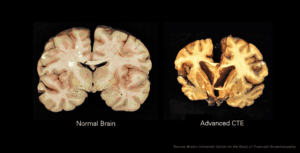
The law firm of Adler Giersch has been at the forefront of brain injury awareness and advocacy for many years with its founding partner, Richard H. Adler, as a local and national advocate for safety in youth sports. He drafted legislation and organized a strong local coalition of doctors, sports organizations, insurers, and many others that led to the Zackary Lystedt Law, named after his client, the nation’s very first law designed to prevent traumatic brain injuries in student athletes by requiring school districts and nonprofit organizations using school facilities to adopt policies for management of concussion and head injury in youth sports. Following the passage of Washington’s Lystedt Law, every state followed its core principles and now all 50 states have a mandatory removal and managed return to play protocol in place that is aimed at protecting youth athletes from sustaining life threatening head injuries while playing sports.
A recent medical study published in in the Journal of the American Medical Association (JAMA) shows that there remains ongoing need for awareness, education, implementation and enforcement of player safety to prevent traumatic brain injuries from youth sports to professional athletes.
On the professional sports level, the recent study looked at the brains donated for research by former NFL greats such as Hall of Famer Ken Stabler to journeyman lineman. We have all heard about Tiaina “Junior” Seau, former linebacker for the San Diego Chargers, Miami Dolphins, and the New England Patriots, who died May 2, 2012, from a self-inflicted gunshot to the chest. Not to mention Terry Long, Andre Waters, Shane Dronett, David Duerson, and Ray Easterling, all of whom also ended their own lives. Most recently, there was 31 year old wide receiver James Hardy, who died June 7, 2017, when he drowned in a river. Hardy was a second round pick for the Buffalo Bills in 2008. His death was recently ruled a suicide.[1] While it has yet to be determined if Hardy had CTE, what is true for all the other athletes above is that autopsies confirmed the presence of CTE in every one of them.
Chronic traumatic encephalopathy (CTE) is a progressive neurodegenerative disease that has often been associated with repetitive blows to the head. Early symptoms can be mild disorientation and headaches and progress to memory loss, erratic behavior, dementia, depression, and thoughts of suicide. While this was commonly associated with boxing initially, research is showing that this is not just boxing but also football and other sports as well.
The new study published in JAMA suggest that participation in football may be related to the development of CTE.[2] The researchers examined 202 brains of former deceased football players. What they found was the presence of CTE in 177 players, or 87% of those studied.[3] Of those studied, researchers found the most common cause of death for participants with mild CTE pathology was suicide (27%) and for those with severe CTE pathology was neurodegenerative (47%). The study also found that cognitive problems were common in those diagnosed with CTE, with symptoms occurring in 85% of the mild cases and 95% in the severe cases. Language and visuospatial symptoms occurred in 66 of the mild cases and 54% in severe cases.[4]
The donors to the brain bank program were primarily college and professional level players, even though there are many more players who only played on youth or high school teams. Particularly noteworthy is that the severity of CTE pathology was distributed across the highest level of play from high school to professional players. All former high school players involved in the study had some level of CTE pathology, and the majority of former college (56%), semiprofessional (56%), Canadian Football League (86%), and NFL (86%) players had severe pathology.[5]
This study is important as it continues the public’s discussion about traumatic brain injury and roads that can lead to prevention and safety. Sports related head trauma is one cause of neuro-cognitive changes but so are other causes such as falls, motor vehicle crashes, bicycle, and pedestrian mishaps. It is clear from this study and others that rule changes are needed to make football and other sports that are known to cause brain injuries, such as girls’ soccer, more safe. The problem of brain damage showing up in NFL players later in life begins with youth sports. This is why parents, athletes, coaches, and school administrators need to more fully embrace and enforce the core principles of Washington’s Lystedt Law.
[1] As reported in USA Today, July 19, 2017.
[2] Mez et al., “Clinical Evaluation of Chronic Traumatic Encephalopathy in Players of American Football,” JAMA. July 25, 2017;318(4):360-370. doi:10.1001/jama.2017.8334
[3] Ibid.
[4] Ibid
[5] Ibid.
